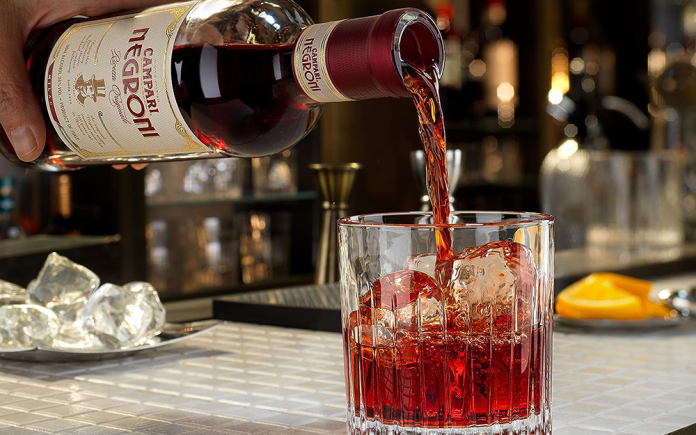
By Rick Riozza
So I pulled into a well-known Palm Springs bar for a quick libation after work. I asked the bartender what’s cooking? She knows I like to be up on the latest beverage & bar news around town and she told me, “The Negroni is having a moment.”
“A moment?” My tone of voice indicated that I well knew that the Negroni’s popularity has been trending for more than a couple of years now.
“No—Ahh Moment!” she replies. I know her tone of voice and she means here that within the trending times—that the Negroni is skyrocketing, even higher than usual.
She continues to tell me all about the latest books on the Negroni; and, that the cocktail has its own dedicated week each year.
“Geez!—I offer, “You’re a fount of info behind the fountain.” I then tell her that I’m going to write my next column on the Negroni and that I’ll mention her name as my expert consultant.”
“Oh no!” she shakes her head. She’s never been much for fanfare, albeit the bar here is a quite famous haunt for celebs, locals, and visitors alike.
“Tell you what,” I respond, “I’ll keep your name out of my article, if you make me your famous Negroni on the house!
“Sold!” she replies, and starts to whip up my new favorite drink on the block. As you can tell, it was a win-win—everyone’s happy!
So here’s a run-down of her expert testimony:
Not everyone’s cup of tea, the Negroni’s bitter citrusy flavors are both unique and unforgettable. According to Italian folklore, Florentine bartender Forsco Scarselli invented the Negroni in 1919 when Camilo Negroni requested an Americano with gin instead of club soda. With the addition of an orange twist, a cocktail icon was born.
Tthe Negroni’s popularity was limited to Italy for decades. One could say that the Italians had an amore (love) for amari (bitters) before bitter amaro liqueurs like Averna and Fernet became part of the cocktail scene.
Campari—the famous red liqueur, is produced in Milano Italy, and, it must be utilized if you want to craft a truly classic Negroni. Campari is an Italian alcoholic liqueur, considered an apéritif. It’s an infusion of herbs and citrus fruit (chinotto and cascarilla) in high-proof alcohol and sugared syrup.
Invented in the 19th century, it was first previously colored red with bugs—but no one’s going for that these days so the company goes with a synthetic dye (no one talks about that—so fogettabout it!) Campari is both strong and bitter. In terms of strength, Campari’s ABV ranges from 21 to 28.5% around the world. It’s 24% in the US.
So my “undercover” bartender talks as she makes my Negroni. “It’s ridiculously easy with just the following three steps:
- 1:1:1 cocktail (equal parts gin, vermouth, and Campari).
- Add jumbo ice cubes, since they don’t melt too fast.
- Garnish the Negroni with a freshly peeled orange twist.
- No mixer—just gin, Campari, and red vermouth! So prepare for a stronger than usual cocktail.
With the first cool sip, both the bartender and I knew it was liquid love: It was bitter, but also sweet, with strong herbaceous undertones and orange laced throughout. The finish was smooth and refreshing; the large ice cube keeping everything perfectly chilled. I finished it quickly—hoping perhaps she’d offer me another one. But it was too late, another one suddenly appeared before I could think.
Since I’m a gin lover, I didn’t call for the Tanqueray (I’ll keep that flavor profile for my dry Martini). The regular Bombay Gin was fine for the moment. As to the red vermouth, also known as rosso or sweet, why not go with the original Italian vermouth, the Capano Antica Formula, for its vanilla notes and dry finish; Punt e Mes or Cocchi Storico are good choices too.
And comes now an entire fixed cocktail Negroni in a two serving bottle: You guessed it! Campari Negroni—Ricetta Originale. (around $25) Yup!—you can enjoy this one in the comforts of your own home or surroundings in seconds flat! According to the bottle, this is the original recipe by the Campari company—you can’t get closer than that!Saluti!
Back to all of the “Negroni riffs” out there. Most famous among them is the Negroni Sbagliato or a “mistaken/incorrect” Negroni, which swaps gin for prosecco—think of it as the halfway point between a spritz and a Negroni. There’s also the white Negroni with Lillet Blanc and a pleasantly bitter French apéritif called Suze; this liqueur is on the yellow side—so expect a different colored cocktail.
For the famous Boulevadier, use bourbon in place of the gin. If you’re desiring a lower alcohol version, wap out the gin for soda water and the orange peel for a lemon wedge and you’ll have the world favorite Americano! (You folks who know the Italian song, “Americano—Americano”, this is your cue.
Late June is Negroni Week, an annual event when bars around the world serve the cocktails and donate a portion of the proceeds to a charity of their choice. In 2019. Negroni Week was extra special, as the cocktail turned 100. Saluti! Tutti!











































